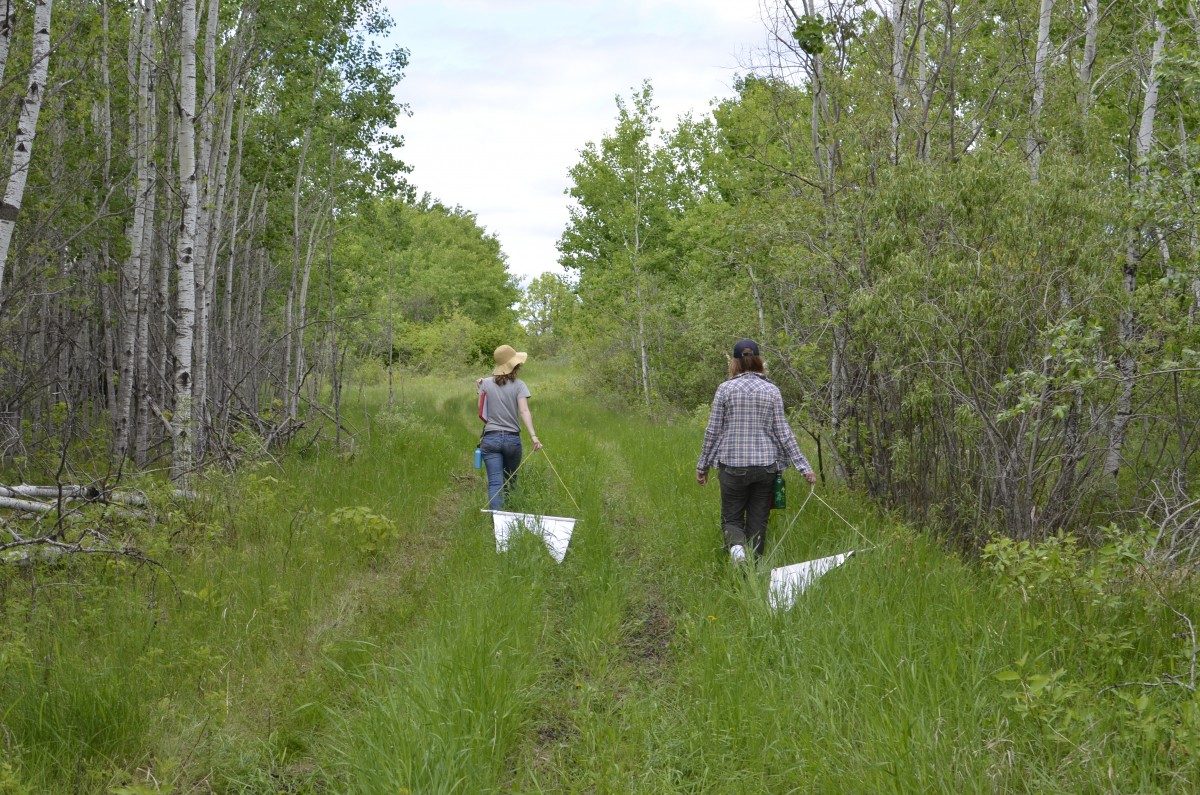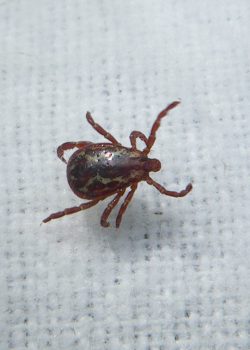
Students drag a flannel sheet to collect ticks.
Ticks on the move
What they might be bringing with them and why you should be concerned
Diploma in Agriculture students in the Advanced Communications and Rural Leadership course (DAGR 0610) wrote articles as part of a research knowledge translation assignment. Today’s featured story was written by Bailey Sigvaldason, with editing by Christine Rawluk.

Male American dog tick.
Bovine anaplasmosis is a bacterial cattle disease caused by a blood borne pathogen transmitted in North America by the Rocky Mountain wood tick and the American dog tick. Until April 2014, bovine anaplasmosis was a federally reportable disease. The effects of this disease include loss of appetite, reduced grazing, reduced milk production, which can lead to deteriorated calf health, anemia, and uncharacteristic behavior of cattle. Because this disease remains in the infected animal’s system for life there is a very high risk of disease transmission via feeding ticks, making it a high priority for producers to predict and control. Dr. Kateryn Rochon is a livestock entomologist with the University of Manitoba, studying the effects arthropods such as ticks have on livestock.
Rochon and colleagues from AAFC Lethbridge and the University of Saskatchewan are currently studying the geographic distribution, abundance and genetic diversity of both these key tick species across Manitoba, Saskatchewan, Alberta and British Columbia. This information will help western Canadian producers to identify risk areas, predict population surges, and manage the occurrence of anaplasmosis in their cattle.
The research began by defining where the current tick populations are situated, something that had not been documented since the 1950’s. Findings show that populations have moved substantially across the prairies. Factors that have been identified as stimuli for tick movement include climate and weather patterns – precipitation levels, vegetation, human and livestock movement and temperature.
“Finding ticks in Manitoba isn’t hard – they come to you,” admits Rochon, “but there have been significant changes as to where and how easily you can find them.” In Manitoba specifically they have begun to move northward, being documented in The Pas and even further north. In Saskatchewan, the team has documented an overlap in the ranges of both the American dog tick and the Rocky Mountain wood tick for the first time. Previously the American dog tick was found in Manitoba and Eastern Saskatchewan and the Rocky Mountain wood tick in Alberta, BC and Western Saskatchewan. “For the first time you can have these two species feeding on the same animals and pathogens could potentially be transmitted to other tick populations and cattle in other parts of the country.” Historically if one population was contaminated it would have been isolated.
The next step in this research is to model these population changes across Western Canada to predict the level of tick presence in any given year, and the risk to cattle producers of exposure to tick-borne diseases such as bovine anaplasmosis. Determining what regulates tick populations will be a major player in this development. This next step will be driven by producer interest and concern into developing management strategies for this disease.
This prairie-wide project is funded by the Beef Cattle Research Council.






